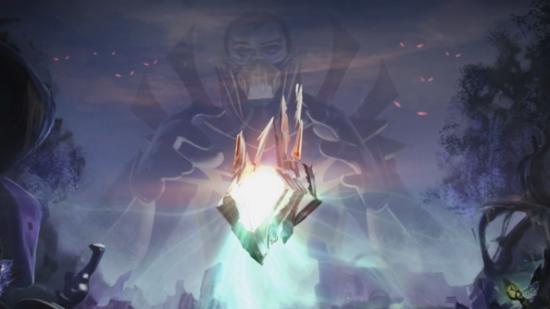I was going to preface this review of Sacred 3 with a gag about nothing being sacred anymore, but I can’t. The game itself has maxed out the global quota for shit jokes, and I’m not laughing. It’s a crude cooperative fantasy brawler that’s completely without charm. Instead, it’s laden with mindless combat and a banal premise involving an evil empire and a plucky resistance.
And it’s important to note that it’s Sacred in setting only. The core elements of the series, the open world ripe for exploration, the day and night cycles and changing weather, the quests – all gone. Now it’s a linear hack and slash game that has more in common with the less popular spin-off, Sacred Citadel.
Keen Games, the developer that’s taken the Sacred mantle from the previous team, Ascaron, shouldn’t be condemned for trying to make their own mark on the series. Changing genres and stripping most of the meat out might seem like an odd approach, but it’s one that could have worked if there was anything there to replace it.
There isn’t.
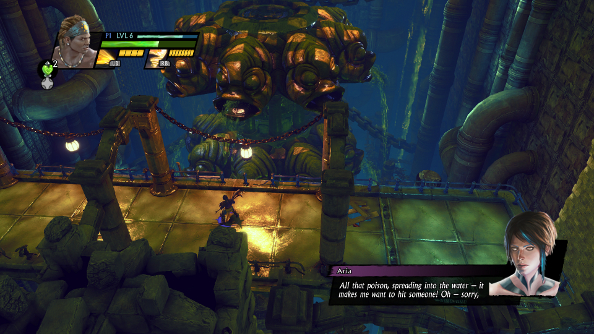
Sacred 3 is a game defined and crippled by its limitations. There are the four heroes, with their inane banter and shallow customisation options; the levels, with their single paths peppered with arenas where waves of foes must be defeated before moving on; the recycled, gormless enemies that spam telegraphed attacks; and a narrative that jumps between bland epic fantasy and forced irreverent gags.
An hour in Sacred 3 is enough so that one can witness everything the game has to offer, and after a few more it becomes an exhausting slog that offers few reasons to push forward.
Obnoxious; that’s what this brawler is. It begins immediately with the gathering of heroes needed to save Ancaria from the extremely silly but never funny Ashen Empire. These heroes are nothing more than walking half-arsed one liners, guided by a telepathic woman who utters such wonderful phrases as “amazeballs”.
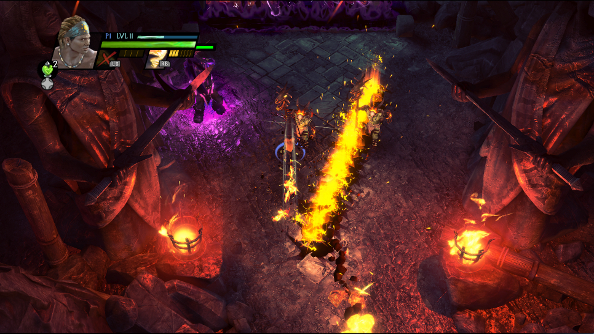
Their mission to save the realm takes them from one level made up of walkways and paths connecting arenas where they are locked into tiresome battles to the next, tied together through a mission select screen. Entering an arena invariably means the heroes are unable to move forward until they kill the waves of uninspired, mainly orc, enemies that pour in from every direction. Imagine Devil May Cry’s fights, but absent the imaginative level design, challenging foes, deep combat mechanics or narrative reason for being locked in an arena.
The maps are ancient ruins, a forest with ancient ruins, a crypt that looks like an ancient ruin, a city that also looks a lot like the previous ruins and the occasional countryside path. Sometimes they cruelly tease junctions and alternative routes, but most of the time it’s just window dressing. A big door with a welcoming light beckons heroes inside can’t be entered just because. The mouth of a cave suggests activity, something’s in there, but what is it? We’ll never know, because the cave ends at the entrance.
These maps are, however, often quite pretty, and Keen Games clearly knows when to draw one’s eye. When running across bridges, the camera usually pulls out, revealing some rather stunning vistas with battles going on below or gargantuan crumbling statues keeping watch.
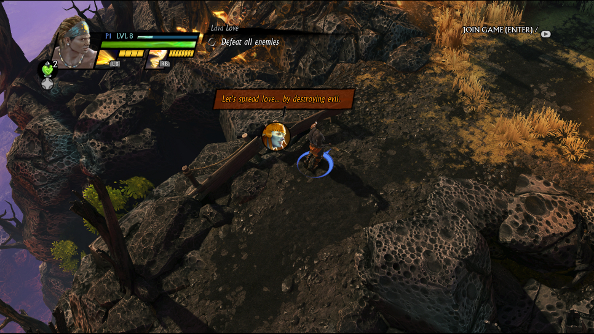
It’s a world I think I would enjoy delving into. But exploration is out of the question. It wouldn’t serve Sacred 3’s purpose, anyway. This is not a game about uncovering loot and myriad secrets; it’s about hitting a few buttons and killing things.
But it’s a hack and slash brawler, so of course fighting is the focus. It’s a shame, then, that this focus doesn’t lead to more entertaining action. It looks like it does, though. Charge into a mass of enemies and they’ll go flying, landing in crumpled heaps on the ground. Unleash a whirlwind attack and you become a deadly tornado, trapping enemies within the weapon arc who can do nothing but die unless you run out of stamina. Flames erupt out of the ground, explosions fling villains and heroes into the air, and the screen is constantly devolving into satisfying chaos.
Actually making those things happen? Not so satisfying.
I ended up putting my mouse and keyboard to rest and tagging in my gamepad. I wasn’t particularly keen on wearing both my finger and my mouse down to dust through manic clicking. Not for movement, though, that’s WSAD, bizarrely. The game seems to be designed for a gamepad anyway, as is clear from the very limited number of abilities heroes can bring with them into battle.
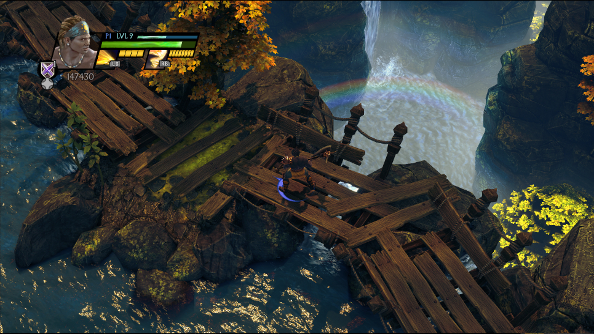
These heroes, which include a bulky, topless man that wields big hammers and axes and a half-naked woman who favours spears, all come with unique combat arts. Special attacks, essentially. They can be unlocked through levelling up and spending gold – besides buying potions, upgrading weapons, armour and combat arts are the only uses for currency – but only two can actually be brought into battle.
It’s one of the most grievous limitations. The visually impressive attacks that at first make the heroes seem like gods are worn down by repetition. The lack of diversity makes each battle feel much like the last.
Encounters involve spamming the same very small number of moves over and over again until everything is dead. Combat arts require stamina, which drops in orb form (along with health) when enemies are killed or resource chests are smashed. Here’s how most fights pan out: spam the basic attack until enough stamina is generated, then spam combat arts until either everything is dead or all stamina is drained. Rinse, repeat, wonder how it came to this.
Most enemies are happy to just throw themselves on swords, under hammers and in front of arrows. Sometimes they’ll even be so kind as to turn their backs. But there are a few that have special abilities. Warriors that become spinning, sword-wielding dervishes, goons hiding behind shields and mages that charge up powerful, life draining magic. All of these abilities can be interrupted or broken with the tap of a button. The bash button, specifically.
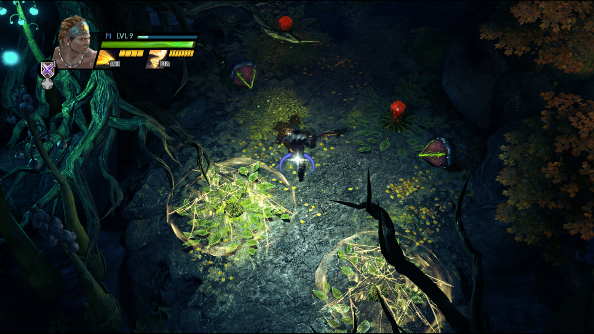
As the game progresses, it becomes more and more common to face hordes of these monsters with multiple spinning maniacs, summoners and shielded orcs all needing their attacks to be interrupted or armour broken at the same time. The bash attack has a cone of effect, so getting into a good position and tapping can neuter many foes at once. It never rises to the point of being a challenge, but it does make enemies, for a moment, engaging.
Bosses and champions are dotted throughout the levels and don’t pose a threat. They are sluggish creatures with telegraphed attacks. The strategy, I use the term as loosely as it’s ever been used, to defeat them is almost always the same. Let them start their attack, roll behind them, hit them, repeat, and perhaps avoid crap that’s falling from the sky. When Keen Games find something they like, they stick with it. And they really like things falling from above.
Attempts to spice up these dull encounters up all fall flat on their face, and are then recycled over and over again. The most common attempts are wheels that must be turned and magical thingymabobs that need to be charged up using stamina. The wheels always have to be turned six times, and stamina bars are drained before the aforementioned thingymabobs are fully charged, requiring a bit more fighting before going back to them. Once was enough, but these occur about once a mission. And all the time, waves of enemies flood the screen.
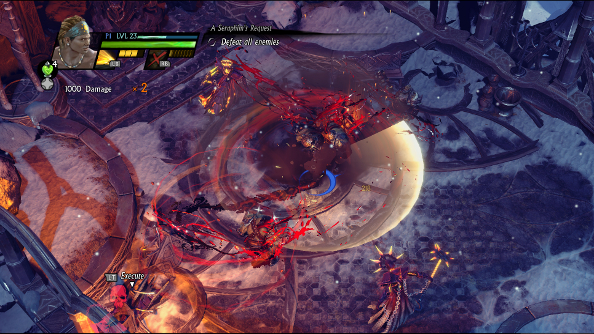
Sacred 3 is a co-op game right down to its presumably tacky love heart boxer shorts. Offline and online options are available, and convenient. Games can be set to completely open, welcoming players of all levels, or only open to players of similar levels.
While foes are appropriately scaled down when playing alone, it’s impossible to shake off the sense that the game doesn’t really like solitary heroes. Quite a few missions task players with destroying catapults, magical orbs, pipes and what have you while waves of monsters continue to pound away. The game’s infuriating guide will, during these sections, nag constantly, repeating that these objects need to be destroyed, advising players to ignore the beasties trying to carve them up.
In co-op, this is fine, because some of the party can focus on hammering away at the objects, while the others defend them from the monstrous onslaught. Solo players, on the other hand, will have to juggle jobs designed for at least two people. And it’s not as simple as clearing the area of foes, as new ones will often keep appearing until the task has been completed.
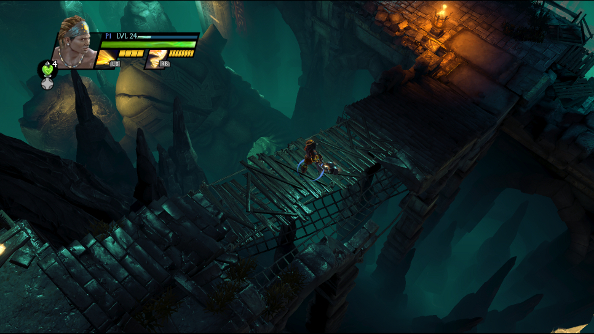
If you’ve played the Sacred RPGs, you’ll probably recall the colourful cast of playable characters like demons, vampires and dryads. While the playable characters in Sacred are a lot tamer, these more vibrant heroes do find their way into Sacred 3. I wish they hadn’t.
Throughout the game, spirits that can be assigned to weapons drop from enemies. They were once dryads and dragons and famous gladiators, but are now – for some unexplained reason – destined to be fixed to hammers and swords. It could have been a colourful touch that made up for the dearth of characters. Instead, these spirits are childish caricatures that will ensure you quickly mute the voice acting. They never shut up, and it’s torture.
From the misogynistic wizard who shouts out one-liners that would make a pimp stereotype cringe, to a dryad that won’t stop saying groovy or other mock hippy phrases, they are all a constant source of torment, spouting their drivel over and over again. They have, perhaps, three or four lines that they repeat ad nauseam. And what do you get for putting up with these bottom of the barrel characters? A buff and a debuff. I cannot conceive of a single person who could find them amusing or playful, so I have to believe they are a bizarre extra challenge. Anyone that makes it through the game without muting these insufferable spirits truly deserves a reward.
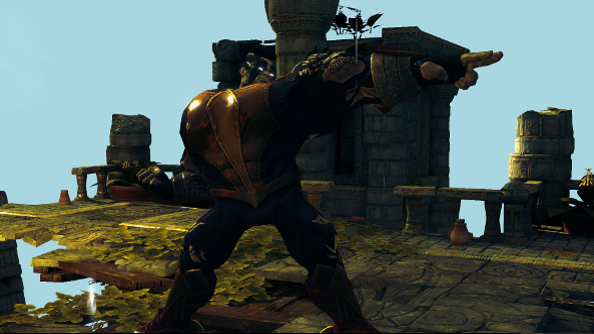
There aren’t any levels that are worth repeating, though the very high level cap certainly suggests that it’s encouraged. Thankfully, there isn’t any need to grind through the same mission over and over again to finish the game. Lamentably, I did encounter a few bugs that led to me doing this anyway. My hulking great warrior got stuck on invisible objects a number of times, necessitating restarting the entire level. One mission kept crashing the game at exactly the same spot, which happened three times in a row and then suddenly didn’t.
One bug, right at the end, inspired me to simply give up and stop playing. Twice in a row, the final boss simply stopped moving or attacking. That would have been fine with me, as I was eager to finish after dragging myself through the last mission, filled with bosses I’d already defeated earlier in the game. But the problem wasn’t that he was stationary; it was that he was invulnerable. “Nope, I’m done,” I said to myself. I quit the game, shut down the PC and reached for the hard liquor.
I have no doubt that some folk will dismiss Sacred 3 because it bears no resemblance to the previous core games in the series. But that’s not why it should be avoided by most. It’s simply not fun to play. The writing is abysmal, the combat is all sizzle and no steak, and, for a rather short game, it regurgitates a hell of a lot. It never rises above mediocrity, but often sinks below it.
